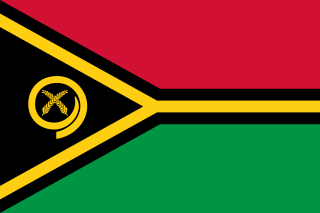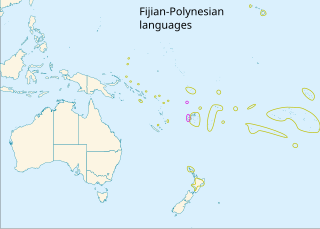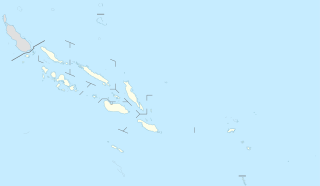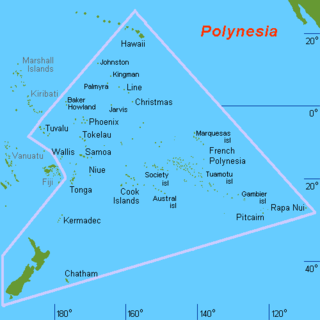
Vanuatu, officially the Republic of Vanuatu, is an island country located in the South Pacific Ocean. The archipelago, which is of volcanic origin, is 1,750 kilometres (1,090 mi) east of northern Australia, 540 kilometres (340 mi) northeast of New Caledonia, east of New Guinea, southeast of the Solomon Islands, and west of Fiji.

The Polynesian languages form a language family spoken in geographical Polynesia and on a patchwork of outliers from south central Micronesia to small islands off the northeast of the larger islands of the southeast Solomon Islands and sprinkled through Vanuatu. Linguistic taxonomists classify them as a subgroup of the much larger and more varied Austronesian family, belonging to the Oceanic branch of that family. Polynesians share many unique cultural traits that resulted from only about 1000 years of common development, including common linguistic development, in the Tonga and Samoa area through most of the first millennium BC.

Nouméa is the capital and largest city of the French special collectivity of New Caledonia. It is situated on a peninsula in the south of New Caledonia's main island, Grande Terre, and is home to the majority of the island's European, Polynesian, Indonesian, and Vietnamese populations, as well as many Melanesians, Ni-Vanuatu and Kanaks who work in one of the South Pacific's most industrialised cities. The city lies on a protected deepwater harbour that serves as the chief port for New Caledonia.

Bellona Island is an island of the Rennell and Bellona Province, in the Solomon Islands. Its length is about 10 km (6.2 mi) and its average width 2.5 km (1.6 mi). Its area is about 17 km2 (6.6 sq mi). It is almost totally surrounded by 30–70 m (100–230 ft) high cliffs, consisting primarily of raised coral limestone.
The Samoic–Outlier languages, also known as Samoic languages, are a purported group of Polynesian languages, encompassing the Polynesian languages of Samoa, Tuvalu, American Samoa, Tokelau, Wallis and Futuna, and Polynesian outlier languages in New Caledonia, the Solomon Islands, Vanuatu, Papua New Guinea, and the Federated States of Micronesia. The name "Samoic-Outlier" recognizes Sāmoan.

Polynesian outliers are a number of culturally Polynesian societies that geographically lie outside the main region of Polynesian influence, known as the Polynesian Triangle; instead, Polynesian outliers are scattered in the two other Pacific subregions: Melanesia and Micronesia. Based on archaeological and linguistic analysis, these islands are considered to have been colonized by seafaring Polynesians, mostly from the area of Tonga, Samoa and Tuvalu.

Taumako is the largest of the Duff Islands, in the Solomon Islands. This 5.7-kilometre-long (3.5-mile) island has steep sides and rises to a height of 400 metres above sea level. It is composed of basaltic lavas and pyroclastics like the other islands in the Duffs.

Anuta is a small high island in the southeastern part of the Solomon Islands province of Temotu, one of the smallest permanently inhabited Polynesian islands. It is one of the Polynesian Outlier communities in Melanesia.

Kapingamarangi is an atoll and a municipality in the state of Pohnpei of the Federated States of Micronesia. It is by far the most southerly atoll or island of the country and of the Caroline Islands, 300 km (190 mi) south of the next southerly atoll, Nukuoro, and 740 km (460 mi) southwest of the main island of Pohnpei state; it forms a Polynesian outlier.

Shefa is one of the six provinces of Vanuatu, located in the center of the country and including the islands of Epi and Efate and the Shepherd Islands.
Futuna is an island in the Tafea province of Vanuatu. It is the easternmost island in the country.

Epi is an island in Shefa Province, Vanuatu, at the north end of the Shepherd Islands.

The Shepherd Islands are a group of islands lying between the larger islands of Epi and Éfaté, in the Shefa province of Vanuatu. The aggregate land area is 88 square kilometres. They were named by Captain Cook after Anthony Shepherd, a British astronomer and friend of Cook.

Aniwa is a small island in the southernmost province of Tafea, Vanuatu.

Polynesia is a subregion of Oceania, made up of more than 1,000 islands scattered over the central and southern Pacific Ocean. The indigenous people who inhabit the islands of Polynesia are termed Polynesians, sharing many similar traits including language family, culture, and beliefs. Historically, they had a strong tradition of sailing and using stars to navigate at night. The largest country in Polynesia is New Zealand.
Mele-Fila (Ifira-Mele) is a Polynesian language spoken in Mele and Ifira on the island of Efate in Vanuatu. In spite of their differences, Mele and Fila are two dialects of the same language and are mutually intelligible. French and English are also fairly common among the residents of Efate.
Emae is a Polynesian outlier language of Vanuatu.

Mataso is an island in the Shefa of Vanuatu in the Pacific Ocean. The island is a part of Shepherd Islands archipelago.

Tongoa Island is an inhabited island in Shefa Province of Vanuatu in the Pacific Ocean.

Tongariki Island is an inhabited island in Shefa Province of Vanuatu in the Pacific Ocean. The island is a part of Shepherd Islands archipelago.

















